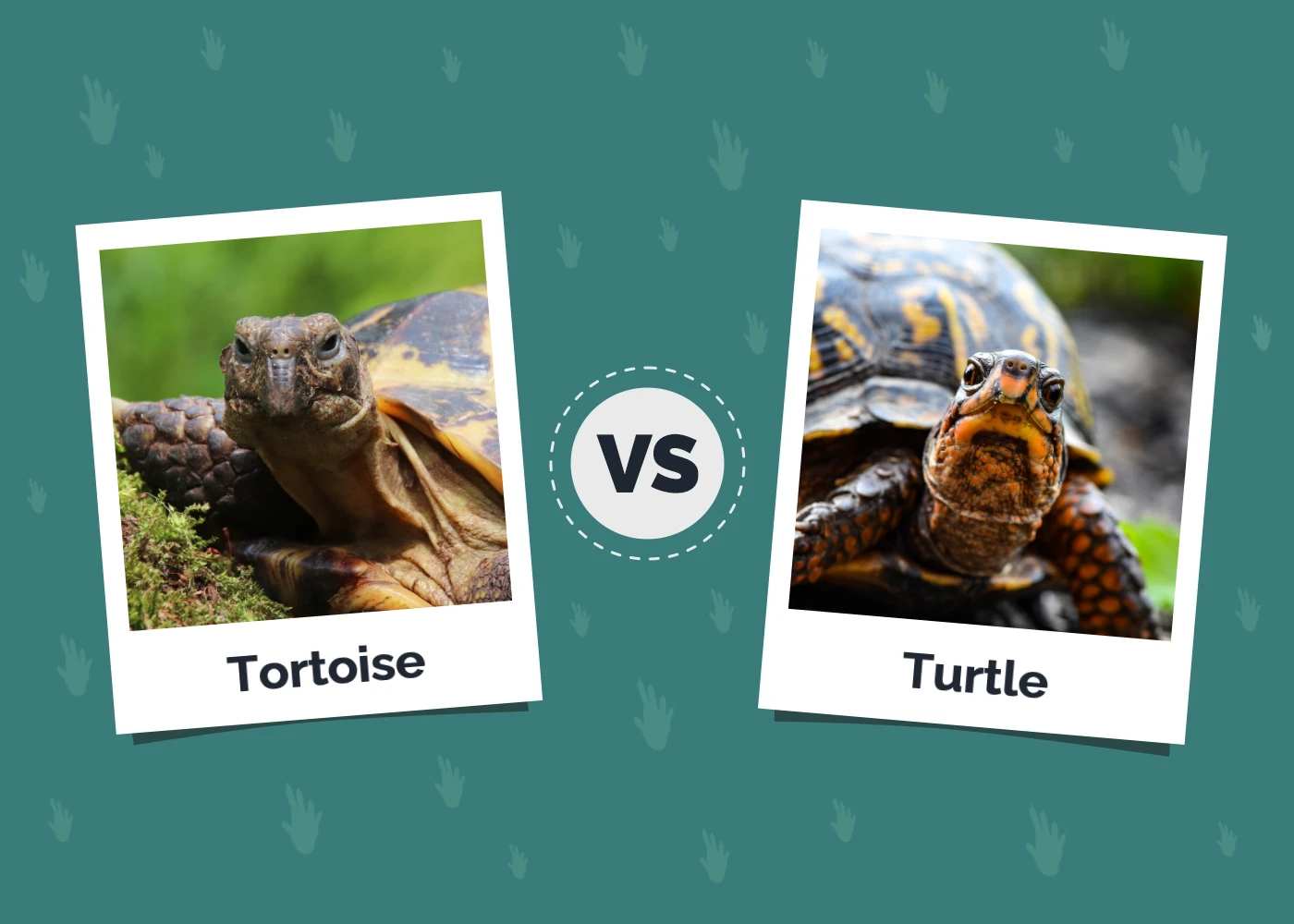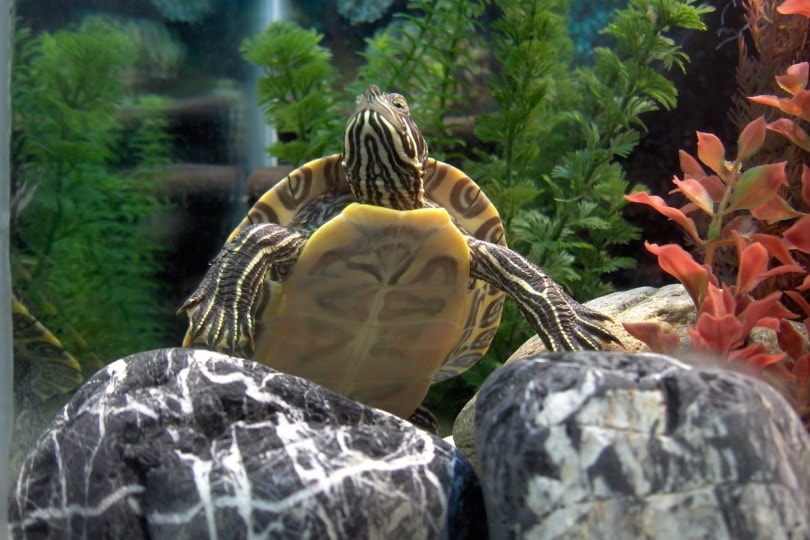Hermann’s Tortoise: Pictures, Facts, Diet, & Care Guide

Updated on
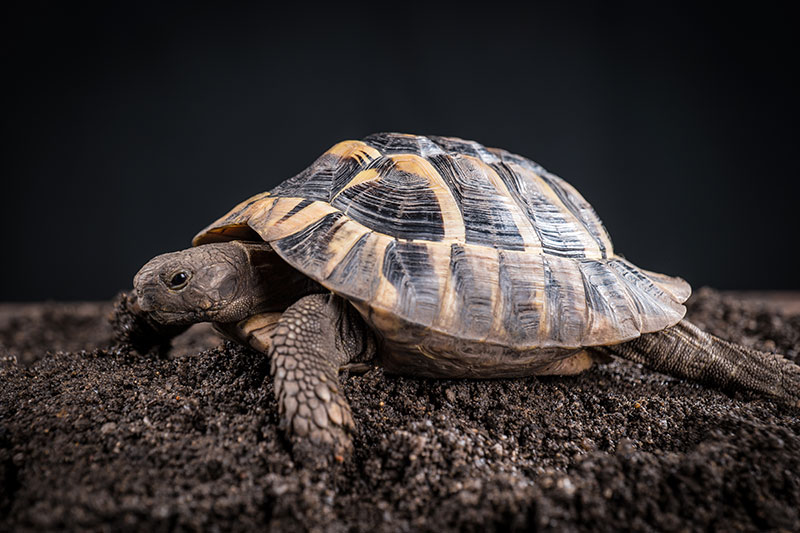
Click to Skip Ahead
Scientifically referred to as the Testudo Hermanni, the Hermann’s Tortoise is one of the 49 tortoise species on the planet. They are endemic around the Mediterranean region of Europe because they only thrive in areas that experience mild weather. Hermann’s are popular among tortoise lovers, and it’s easy to see why, considering their gentle and passive nature.
If you’d like to learn more about this community, keep on reading. We’ll be talking about their behavioral traits, habitat setup, lifespan, health conditions, physical attributes, and diet requirements.
| Size: | 4.5 – 11 inches |
| Weight: | 4.4 – 5.5 pounds |
| Lifespan: | 70 – 100 years |
| Suitable for: | Families that prefer small pets |
| Temperament: | Active, gentle, friendly |
Hermann’s tortoises were once thought to be going into extinction, when humans started using them as food. This was during the Second World War when the food supply was so low that people had to rely on rations. But the good news is that we’ve moved on from those days, as humans no longer use them as food, for the most part.
Regardless, their populations have exponentially grown over the years—even though they are still being affected by climate change and habitat destruction.
Hermann’s Tortoise Breed Characteristics
How Much Do These Tortoises Cost?
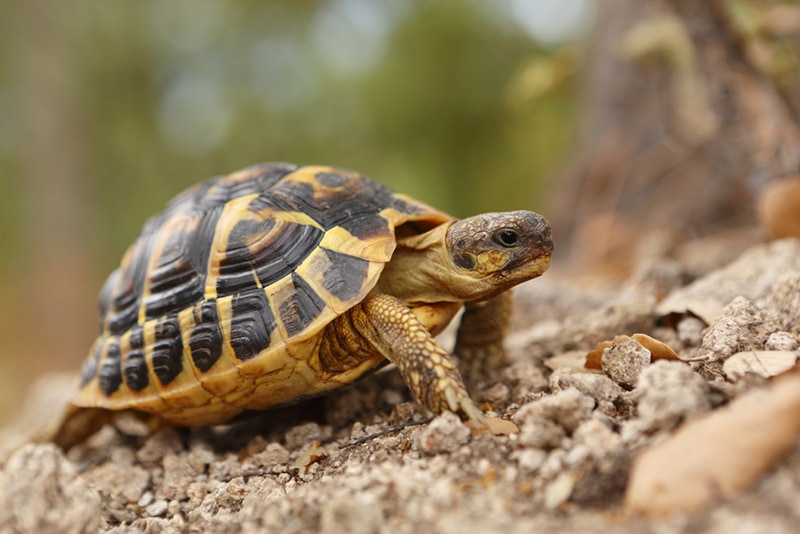
The costs will obviously hinge on a couple of factors, but if we had to give a ballpark figure, we’d say something between $150 and $500. Factors that primarily affect the price are age and origin. Hatchlings or babies are more cost-effective compared to adult Hermann’s due to the expenses incurred while raising them.
The origin factor is all about where the tortoise was bred, or where it came from. If you are going for the Egyptian Hermann’s, be prepared to pay $1,000 or more. Needless to say, it’s because they are considered exotic.
The breeder has to be sure that they are healthy, before putting them on the market. Such guarantees are often costly, seeing as they involve vet examinations, vaccinations, and regular checkups.
Friendly Reminder: Before reaching out to a tortoise dealer or breeder, do your due diligence. You should only work with a reputable breeder, who loves the animals that they are selling and can provide expert care.
The upfront costs are supposed to be budgeted for well in advance. Let’s look at housing, for example. It has to be as large as possible, to avoid future costs of construction. And because tortoises are notorious diggers, you have to fence the enclosure with concrete or brick.
The wall has to extend a couple of feet underground, or your pal will dig a burrow that leads to your neighbor’s yard. If you factor in your location, type of material, and size of its enclosure, the total costs will be fairly high.
Hermann’s Tortoise Behavior
It’s safe to assume that the Hermann is one of the most desired pets, given their responsive, active, and hardy nature. They are also docile and amiable and will only try to bite anyone or anything that poses a threat.
If you’re the type of individual who likes petting or lifting your animal companions, this isn’t the kind of pet you want to get. They dislike being touched or even being lifted, as having all fours on the ground makes them feel secure.
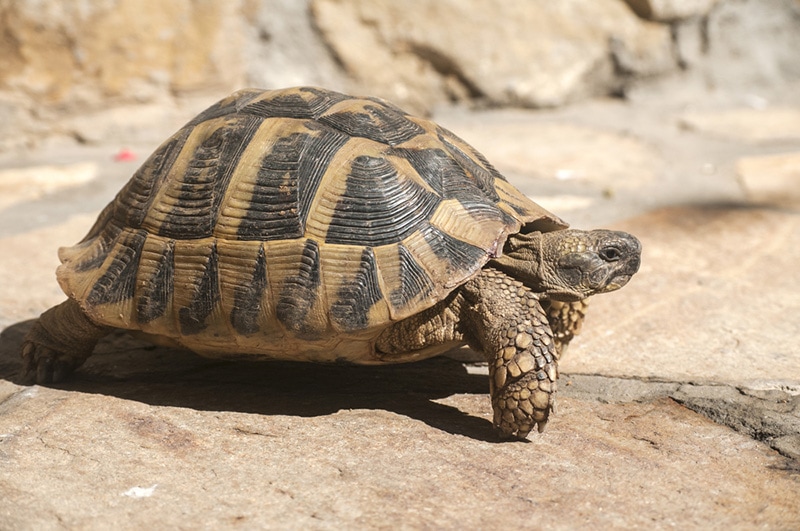
Do Hermann’s Tortoises Make Good Pets?
They are the best long-lived additions to any family, on condition that they are able to gain access to all their essential care requirements. We also find them ideal for those who’ve never owned a pet before, since they are small, active, friendly, calm, and more importantly, gentle.
Hermann’s Tortoise Breed Tank Mates
The worst mistake that you could make as a Hermann pet owner is housing more than one tortoise in an enclosure. While they are very affectionate toward humans and other animals, they tend to get very violent among their peers.
The males are particularly more aggressive during their mating seasons, as they normally feel the need to protect their territories from other males. Courtship is usually not a pleasant experience for the females, as the males love ramming into them to assert dominance.
The only time that you’re allowed to put two Hermann’s tortoises in the same enclosure is when they are ready to mate. Otherwise, they’ll just injure themselves, leaving you with nothing but bills to pay.
Care Sheet & Habitat Setup:
Light Requirement
The Hermann prefers living in habitats that receive lots of sunlight. Their bodies require UVB to be able to synthesize vitamin D3 inside their skin. This fat-soluble secosteroid is important to them, as it facilitates the absorption of not only phosphorus but also calcium. Both minerals are crucial in the formation of healthy bones, hence the reason why inadequate UVB causes metabolic bone disease.
If you’ll be setting up your tortoise’s enclosure indoors, remember to install a fluorescent UVB tube and a reflector. You could go for the T8 or T5 UVB tubes, depending on your tortoise’s needs and the size of the enclosure.
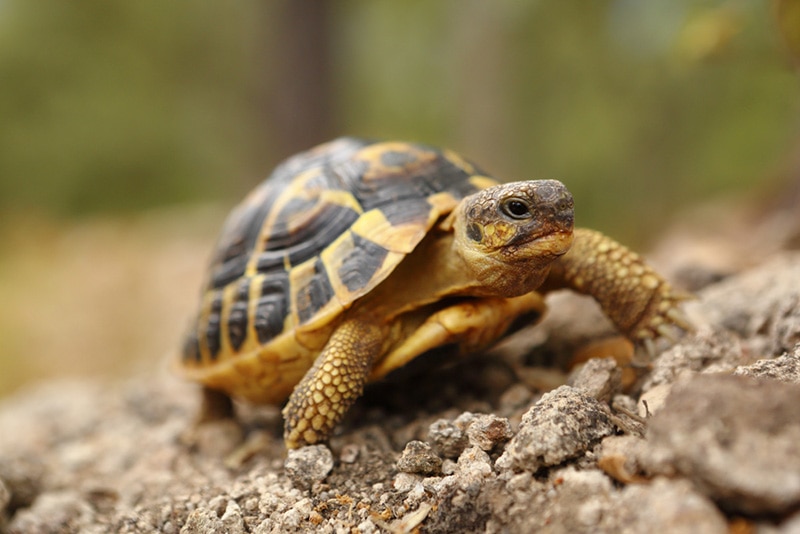
Enclosure Size
The size of your enclosure will be influenced by the age of the tortoise and the availability of space. But we like to advise our audiences to just go for the biggest possible enclosure, to give the tortoise more room to roam around should they feel the need to.
Plants
If you want to make your tortoise’s new home relaxing, plant some species that they love. Herpetologists say these reptiles love hanging around the tropical hibiscus, not just because it provides ample shade, but also due to the fact that their leaves and flowers are nutritious.
Geranium is also not a terrible option, but we don’t like using it because it will eventually produce a dense ground cover that will make it difficult to find your tortoise if it’s hiding.
Substrate
Your Hermann’s favorite hobby will be to dig burrows any chance they get. And this is not an issue if they’ll be living outside. But if you reside in regions characterized by freezing temperatures, the enclosure has to be indoors.
And that means you’ll have to provide sufficient substrate to encourage that activity. We recommend using a mix of cypress bark, soil, and sand. Add some alfalfa pellets if you can find some, as tortoises are known to eat their substrate.
Things to Know When Owning a Hermann’s Tortoise:
Food & Diet Requirements
The Hermann’s tortoise survives mostly on plant matter, but they occasionally forage for snails and insects. In captivity, they are supposed to be fed fruits, grasses, flowers, and a wide variety of herbaceous plants. It’s important to supplement their natural food with some mineral-vitamin products to ensure they aren’t deficient in any nutrient department.
If you’re planning to offer them ready-made plant food, go for something that has high amounts of phosphorus, calcium, retinol, and vitamin D3.
Fruits with high-water content are often discouraged, as they could cause excessive intestinal activity. Blueberries, strawberries, raspberries, and blackberries are the healthiest options. If you’ve noticed that your tortoise’s shell appears to have a pyramid shape, the diet that you’ve been working with is not balanced. And if it is, you’ve been overfeeding them.

Size & Growth Chart
We should have kicked this off by letting you know that we have two Hermann tortoise subspecies. And this is important because one of the subspecies is normally larger in size as an adult. Of course, both subspecies are endemic to Europe, but one’s found in the eastern regions, while the other dwells in the western parts.
| Western Hermann Tortoise | Size |
| Hatchling | 1.5 inches |
| Yearling (1–2 years) | 2.25 – 2.5 inches |
| Adult (Over 10 years) | 4.5 – 9 inches |
| Eastern Hermann Tortoise | Size |
| Hatchling | 1.5 inches |
| Yearling (1–2 years) | 2.25 – 2.5 inches |
| Adult (Over 10 years) | 9 – 11 inches |
Lifespan and Health Conditions
This breed is able to live for more than 70 years, if the conditions are right. They aren’t high maintenance, but you still have to attend to their needs.
Soak them at least twice per week to get rid of all the dirt that would precipitate the growth of parasites, and to help them stay hydrated. If you don’t soak them regularly, their skin and shell will start forming cracks, due to dryness.
The hatchlings are to be soaked daily, for more than 10 minutes. The water temperature needs to be 85ºF (29.4ºC) and not lower or higher.
It’s important to note that tortoises are cold-blooded creatures. So, if the temperature outside keeps falling, their metabolism will be negatively affected. All their physiological activities, from reproduction to digestion, will slow down as well.
Some of the health conditions to look out for include:
- Ticks and mites: Your Hermann tortoise will seem hyperactive and restless. The parasites will be attached to their skin, causing inflammation.
- Vitamin deficiency: Being categorized as a minor condition doesn’t imply that it’s not serious enough to lead to death. Because it could, if left untreated. Multivitamin supplementation is the only way to resolve the issue.
- Respiratory tract infection: Usually caused by an undiagnosed underlying infectious, unsuitable humidity, or extreme temperatures. The symptoms are pretty clear, as your tortoise will have labored breathing.
- Gastrointestinal disease: Nutritional imbalance could be the cause, but more often than not, it’s parasitic, viral, or bacterial infections. If your tortoise is experiencing gastrointestinal issues, it’ll keep passing runny stools. Rapid weight loss is another symptom.
Male vs Female
Sexual dimorphism is evident in the Hermann’s tortoise community. Unlike other species, the females are always larger than their male counterparts, and heavier. This is an observation made in both subspecies.
3 Little-Known Facts About Hermann’s Tortoise
1. The Hermann tortoise can sleep for 4–5 months if that’s what it takes to survive the winter season.
2. This species has never been declared threatened but was once close to attaining that conservation status.
3. Most of the calcium and phosphorus minerals absorbed by their bodies are used to strengthen their shells and scales so that they can be sturdy enough to protect them from serious injury.
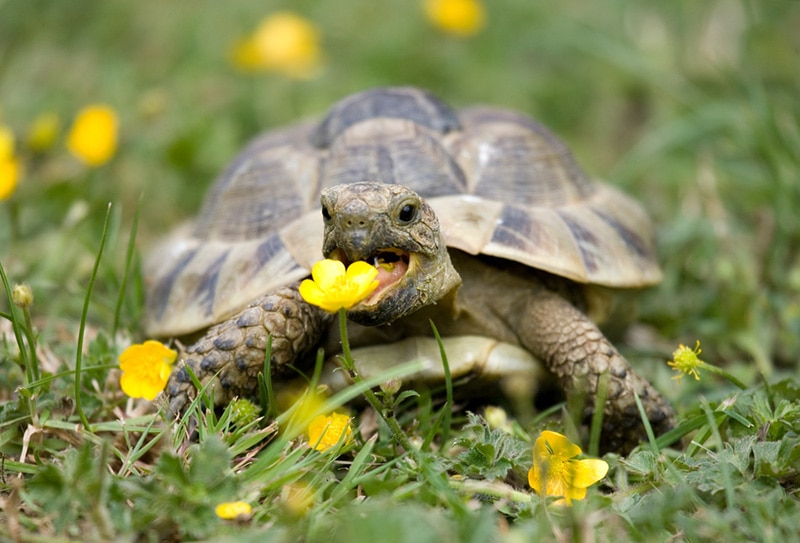
Final Thoughts
Is Hermann’s tortoise the right pet for you? Well, it could be, if the weather is great. They don’t usually thrive in extreme temperatures, especially if they are kept outside. Also, they require unlimited space and natural sunlight to absorb enough UVB. If they can’t access UVB, their bodies won’t be able to synthesize vitamin D3, which is essential to the process of bone formation.
Related Read:
- How Big Do Hermann Tortoises Get? Average Weight & Growth Chart
- How Long Do Hermann’s Tortoises Live: Average Lifespan, Data & Care
Featured Image Credit: Ketta, Shutterstock


